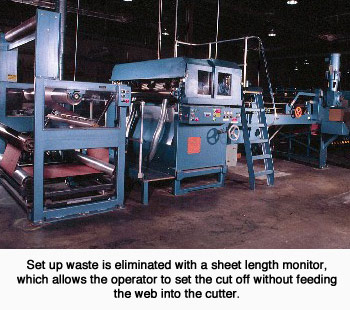As a converter of office filing products, Universal Paper Goods has earned a reputation for quality and service. Since it was founded in 1922, the company has grown from a small converter to a major supplier, with a customer base concentrated in the Western U.S. This growth prompted the attention of Esselte Pendaflex Corporation, which acquired Universal in 1986.

At the company’s Los Angeles, CA facility, operations include die cutting, sheeting, printing, and various other types of converting. In addition to stocking a complete line of standard filing products. Universal also offers specialty items. According to Duncan Moffat, the company’s plant manager, specials have become a greater part of the company’s business.
Until recently, sheeting was performed in-house on an older sheeter. In the face of increased demand for their office filing products. Universal found its production capacity was limited by the sheeter’s slow operating speeds. As sales increased, the unit simply could not keep up with demand. This led Universal to consider replacing their existing equipment.
As Moffat recall, “Our old sheeter required a lot of maintenance, and we reached a point where it was not serving our needs. Most everything we do starts at the sheeter. That’s why we must have capacity, flexibility, and efficiency at that critical work area.”
After considering several sheeter designs, Universal Paper Goods selected a MSL Sheeter from Maxson Automatic Machinery Company (Westerly, RI). “We saw the machine at a trade show, and we were impressed with its speed, accuracy and reliability,” says Moffat. Safety features and ease of operation were also considerations.
The MSL Sheeter cuts lightweight board ranging from 0.011″ – 0.018″ thick. Operating speeds on the new sheeter average 700 fpm, compared to 150 fpm on the unit it replaced. This speed gain has given the company the extra capacity it needed to turn orders around quickly.

Equipped with a close tolerance drive, the MSL Sheeter provides press-ready sheets. For ease of operation, the MSL also has a clutch box design which simplifies size changes. The clutch box reduces setup time by allowing the operator to set the desired sheet length range automatically. With this feature, setups are accomplished in 2-3 minutes.
Options Increase Sheeter Productivity
Options selected included a decurl station, which conditions the web and prevents jam-ups due to curl at the press. “With the decurl unit, we can now sheet all the way to the end of the roll. Waste is now at an acceptable level,” replies Moffat.
A slitter rig was selected as an equipment option and can slit the web into four piles. With this option, Universal no longer has guillotine trim to achieve a finished size. The sheeter also features a sheet length monitor which allows the operator to set the cutoff without feeding the web into the cutter. In this way, setup waste is eliminated.
This view of the stacker shows the neatly jogged sheets ready for die cutting and printing.
Since startup, the sheeter has helped Universal gain a competitive edge in the area of service. Stock items are maintained in inventory and lead times on special orders have been reduced. To plan for future growth. Universal will install Maxson’s Airfoil Overlap system on the new sheeter. The Airfoil eliminates jam-ups at the point of overlap, and as a result, higher speeds can be maintained.
The decision to replace older equipment has given Universal the capacity it needed fro future growth. Adds Moffat, “It now takes less people overall to run and maintain the new sheeter. With the Maxson, our converting operation is getting off on the right foot. It has also put us in a position to plan for future growth.”
Reprinted from The Sheeting Monitor, December 1990






